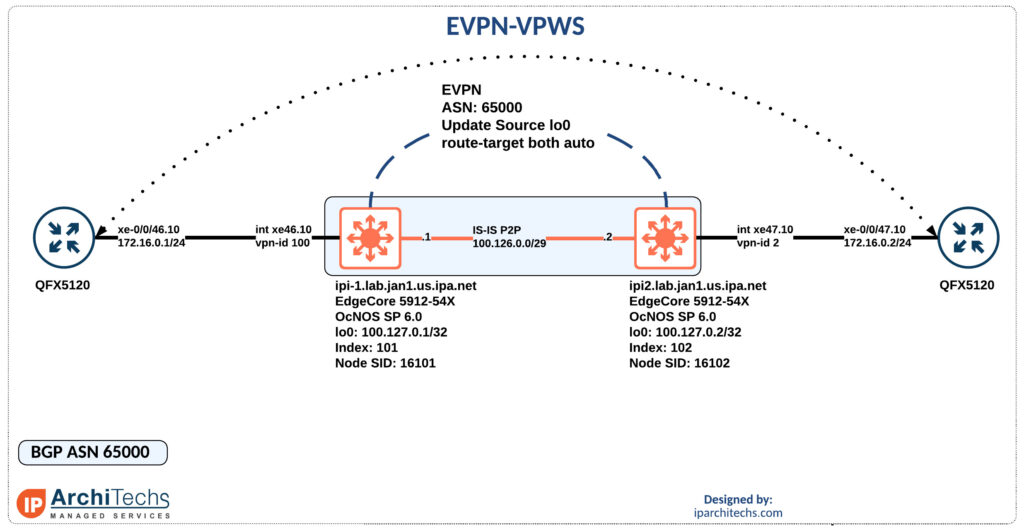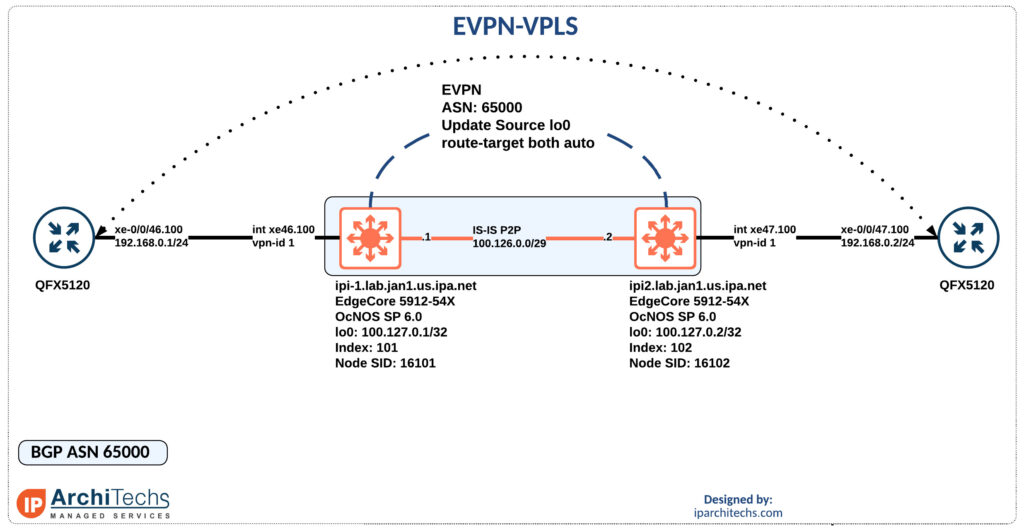IP Infusion just released OcNOS version 6.0 and the release notes, as well as press release, show a focus on EVPN with an MPLS data plane. Don’t forget EVPN and VxLAN aren’t mutually exclusive, EVPN runs on and was originally designed for a MPLS data plane. I recently discussed this on a podcast EVPN doesn’t need VxLAN if you want to know more on that topic.
Lets take a look at basic EVPN-VPWS and EVPN-VPLS deployment. Since we’re looking at an MPLS data plane we will utilize ISIS-SR for MPLS. We’re utilizing ISIS-SR as it is increasingly replacing LDP and RSVP-TE for label distribution.

IGP and Label Distribution
First let’s look at the IGP setup and label distribution as everything else will be built on top of this.
ipi-1.lab.jan1.us.ipa.net#show run int lo
interface lo
ip address 127.0.0.1/8
ip address 100.127.0.1/32 secondary
ipv6 address ::1/128
ipv6 address 2001:db8::1/128
prefix-sid index 101
ip router isis UNDERLAY
ipv6 router isis UNDERLAY
!We have to set an index to create the node-sid for this device. In this case we use 101.
ipi-1.lab.jan1.us.ipa.net#show run segment-routing
segment-routing
mpls sr-prefer
global block 16000 23999Since our segment routing global block starts at 16000 the node-sid becomes 16101 as the index + the start of the SRGB defines the sid. Additionally, we run mpls sr-prefer as this will prefer SR labels over LDP or RSVP-TE labels.
ipi-1.lab.jan1.us.ipa.net#show run isis
router isis UNDERLAY
is-type level-1-2
metric-style wide
mpls traffic-eng router-id 100.127.0.1
mpls traffic-eng level-1
mpls traffic-eng level-2
capability cspf
dynamic-hostname
fast-reroute ti-lfa level-1 proto ipv4
fast-reroute ti-lfa level-2 proto ipv4
net 49.0015.1001.2700.0001.00
segment-routing mpls
!Finally, we have to enable ISIS for segment routing.
ipi-1.lab.jan1.us.ipa.net#show clns neighbors
Total number of L1 adjacencies: 1
Total number of L2 adjacencies: 1
Total number of adjacencies: 2
Tag UNDERLAY: VRF : default
System Id Interface SNPA State Holdtime Type Protocol
ipi-2.lab.jan1.us.ipa.net xe48 3c2c.99c0.00aa Up 26 L1L2 IS-ISipi-1.lab.jan1.us.ipa.net#show mpls ilm-table
Codes: > - installed ILM, * - selected ILM, p - stale ILM
K - CLI ILM, T - MPLS-TP, s - Stitched ILM
S - SNMP, L - LDP, R - RSVP, C - CRLDP
B - BGP , K - CLI , V - LDP_VC, I - IGP_SHORTCUT
O - OSPF/OSPF6 SR, i - ISIS SR, k - SR CLI
P - SR Policy, U - unknown
Code FEC/VRF/L2CKT ILM-ID In-Label Out-Label In-Intf Out-Intf/VRF Nexthop
LSP-Type
i> 100.127.0.1/32 4 16101 Nolabel N/A N/A 127.0.0.1
LSP_DEFAULT
B> evpn:1 3 17 Nolabel N/A N/A 127.0.0.1
LSP_DEFAULT
B> evpn:100 1 16 Nolabel N/A N/A 127.0.0.1
LSP_DEFAULT
B> evpn:1 2 640 Nolabel N/A N/A 127.0.0.1
LSP_DEFAULT
P> 100.127.0.2/32 7 20 3 N/A xe48 100.126.0.2
LSP_DEFAULT
i> 100.126.0.2/32 5 26240 3 N/A xe48 100.126.0.2
LSP_DEFAULT
i> 100.127.0.2/32 6 16102 3 N/A xe48 100.126.0.2
LSP_DEFAULTNow we can see that we have a clns/isis neighbor with ipi-2 as well as learned labels. We can see both device’s node-sids in the label table on ipi-1.

BGP EVPN Setup
Next we can build EVPN on top of the underlay to begin delivering services. First we have to build an EVPN BGP session between the two routers.
ipi-1.lab.jan1.us.ipa.net#show run bgp
!
router bgp 65000
neighbor 100.127.0.2 remote-as 65000
neighbor 100.127.0.2 update-source lo
!
address-family l2vpn evpn
neighbor 100.127.0.2 activate
exit-address-family
!ipi-1.lab.jan1.us.ipa.net#show bgp l2vpn evpn summary
BGP router identifier 100.127.0.1, local AS number 65000
BGP table version is 32
1 BGP AS-PATH entries
0 BGP community entries
Neighbor V AS MsgRcv MsgSen TblVer InQ OutQ Up/Down State/PfxRcd AD MACIP
MCAST ESI PREFIX-ROUTE
100.127.0.2 4 65000 22856 22856 32 0 0 6d18h34m 2 1 0
1 0 0EVPN-VPWS

Next we can start build services on top. First we’ll build an EVPN-VPWS service.
ipi-1.lab.jan1.us.ipa.net:
!
evpn mpls enable
!
evpn mpls vtep-ip-global 100.127.0.1
!
mac vrf BLUE
rd 100.127.0.1:1
route-target both evpn-auto-rt
!
evpn mpls id 100 xconnect target-mpls-id 2
host-reachability-protocol evpn-bgp BLUE
!
interface xe46.10 switchport
encapsulation dot1q 10
access-if-evpn
map vpn-id 100
!EVPN MPLS has to be enabled. *IMPORTANT* This requires a reboot. Next the vtep id needs to be set. These are global settings for the environment.
For the creation of the service we’ll start by making a mac vrf to generate the information needed to create a EVPN type 2 route (mac-ip).
Since this is VPWS it is considered a cross connect xconnect and a target is defined. This is the remote PE vpn-id, in this case 2.
Finally it is assigned to a switchport. It has to be a switchport with a type of access-if-evpn. This maps back to the EVPN mac-vrf via the xconnect. Anything arriving on xe46.10 with a dot1q tag of 10 is placed into this tunnel.
ipi-1.lab.jan1.us.ipa.net#show evpn mpls xconnect
EVPN Xconnect Info
========================
AC-AC: Local-Cross-connect
AC-NW: Cross-connect to Network
AC-UP: Access-port is up
AC-DN: Access-port is down
NW-UP: Network is up
NW-DN: Network is down
NW-SET: Network and AC both are up
Local Remote Connection-Details
================================ ============ ==========================================================================
=========
VPN-ID EVI-Name MTU VPN-ID Source Destination PE-IP MTU Type NW
-Status
================================ ============ ==========================================================================
=========
100 ---- 1500 2 xe46.10 --- Single Homed Port --- 100.127.0.2 1500 AC-NW NW
-SET
Total number of entries are 1ipi-1.lab.jan1.us.ipa.net#show evpn mpls xconnect tunnel
EVPN-MPLS Network tunnel Entries
Source Destination Status Up/Down Update local-evpn-id remote-evpn-id
========================================================================================================
100.127.0.1 100.127.0.2 Installed 01:31:06 01:31:06 100 2
Total number of entries are 1The tunnels are up, installed, and ready for forwarding. We can see the CE macs as mac-ip routes in evpn.
ipi-1.lab.jan1.us.ipa.net#show bgp l2vpn evpn vrf BLUE
BGP table version is 1, local router ID is 100.127.0.1
Status codes: s suppressed, d damped, h history, a add-path, * valid, > best, i - internal,
l - labeled, S Stale
Origin codes: i - IGP, e - EGP, ? - incomplete
[EVPN route type]:[ESI]:[VNID]:[relevent route informantion]
1 - Ethernet Auto-discovery Route
2 - MAC/IP Route
3 - Inclusive Multicast Route
4 - Ethernet Segment Route
5 - Prefix Route
Network Next Hop Metric LocPrf Weight Path Peer Encap
* i [1]:[0]:[2]:[16] 100.127.0.2 0 100 0 i 100.127.0.2 MPLS
*> [1]:[0]:[100]:[16]
100.127.0.1 0 100 32768 i ---------- MPLS
Total number of prefixes 2The mac addresses are sent via an EVPN type-2 route between PEs.
ipi-1.lab.jan1.us.ipa.net#show evpn mpls mac-table
========================================================================================================================
=================
EVPN MPLS MAC Entries
========================================================================================================================
=================
VNID Interface VlanId In-VlanId Mac-Addr VTEP-Ip/ESI Type Status MAC mo
ve AccessPortDesc
________________________________________________________________________________________________________________________
_________________
Total number of entries are : 0Since this is VPWS there are no macs learned on the device.
[email protected]# run ping 172.16.0.2
PING 172.16.0.2 (172.16.0.2): 56 data bytes
64 bytes from 172.16.0.2: icmp_seq=0 ttl=64 time=21.531 ms
64 bytes from 172.16.0.2: icmp_seq=1 ttl=64 time=22.124 msSuccess! The CEs can reach each other over the EVPN-VPWS circuit.
EVPN-VPLS

Now we’ll build an EVPN-VPLS service. The BGP setup is the same so we’ll focus solely on the differences. The first one being the vpn-id creation.
mac vrf ORANGE
rd 100.127.0.1:2
route-target both evpn-auto-rt
!
evpn mpls id 1
host-reachability-protocol evpn-bgp ORANGE
!There is no end point defined as a xconnect. All that is necessary is to bind the mac vrf to the evpn vpn id.
interface xe46.100 switchport
encapsulation dot1q 100
access-if-evpn
map vpn-id 1
!Again, a switchport defined as an access-if-evpn is necessary. This is then mapped to the vpn-id for the VPLS service. In this case anything coming in with a dot1q tag of 100 will be placed into vpn-id 1.
ipi-1.lab.jan1.us.ipa.net#show evpn mpls mac-table
========================================================================================================================
=================
EVPN MPLS MAC Entries
========================================================================================================================
=================
VNID Interface VlanId In-VlanId Mac-Addr VTEP-Ip/ESI Type Status MAC mo
ve AccessPortDesc
________________________________________________________________________________________________________________________
_________________
1 xe46.100 ---- ---- 84c1.c132.5031 100.127.0.1 Dynamic Local ------- 0
-------
1 ---- ---- ---- 84c1.c132.5032 100.127.0.2 Dynamic Remote ------- 0
-------
Total number of entries are : 2Since this is a VPLS service MACs are learned both locally and remotely. The remote MAC is the MAC of the remote CE. This was learned via EVPN and from the VTEP 100.127.0.2.
ipi-1.lab.jan1.us.ipa.net#show bgp l2vpn evpn mac-ip vrf ORANGE
ESI Eth-Tag Mac-Address IP-Address VNID/LABEL L3VNID
Nexthop GW-Type Encap
0 1 84c1:c132:5031 -- 17 0
100.127.0.1 -- MPLS
0 1 84c1:c132:5032 -- 17 0
100.127.0.2 -- MPLSThe type-2 routes are populated in the BGP table.
[email protected]# run ping 192.168.0.2
PING 192.168.0.2 (192.168.0.2): 56 data bytes
64 bytes from 192.168.0.2: icmp_seq=0 ttl=64 time=21.894 ms
64 bytes from 192.168.0.2: icmp_seq=1 ttl=64 time=22.159 msSuccess! We have reachability across the service.
Conclusion
IP Infusion is continuing to build their evpn/mpls deployment as well as segment routing. It is exciting to see these feature sets continue to mature as traditional LDP/VPLS deployments move to EVPN/MPLS. If you need assistance on the transition from LDP to segment routing or VPLS to EVPN reach out to IP Architechs.
 +1 (855) 645-7684
+1 (855) 645-7684